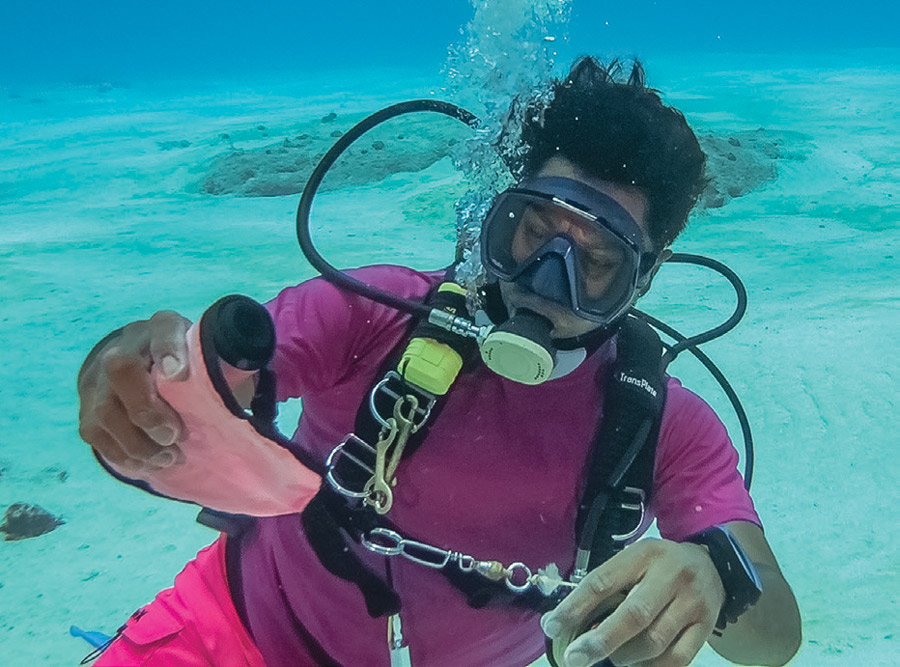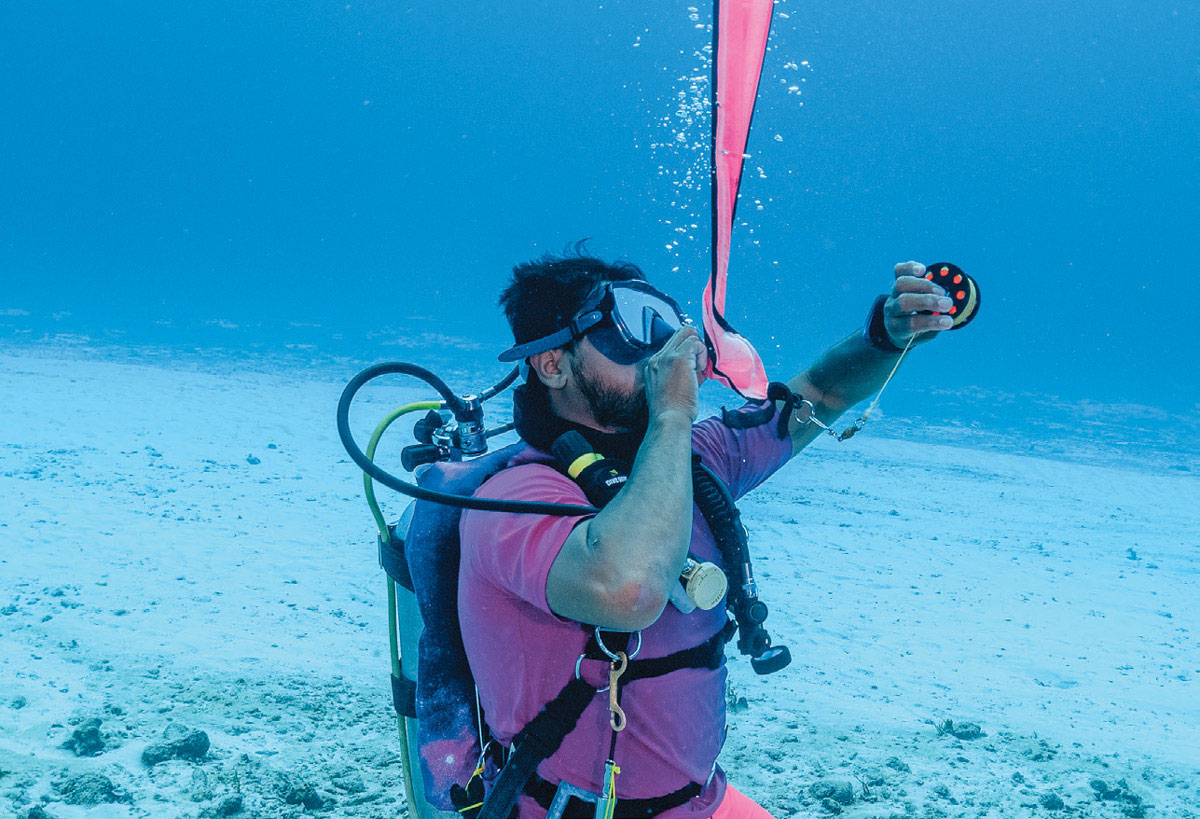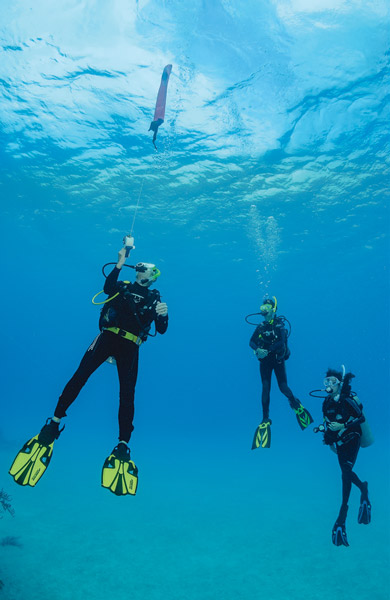ONE ESSENTIAL PIECE of accessory equipment every diver needs to carry is the “safety sausage” or surface marker buoy (SMB). This device may also be referred to as a DSMB (delayed or deployable surface marker buoy). The purpose of these buoys is to help you be located quickly and easily during and/or after a dive. Knowing how to deploy an inflatable buoy is important, so let’s get started.
Safety Sausage Basics
An SMB or safety sausage can be any type of buoyant object used to indicate a diver’s position — a ring buoy, a large round float or a diver down flag mounted on a float and pole, for instance. For the purposes of this article, the SMB we’re describing is a portable, inflatable tube ranging from 3 to 6 feet (1 to 2 m) feet in length. SMBs come in bright colors, enabling boat crews and fellow divers to locate your position. Common colors are orange, red, pink and yellow. In some locations, yellow is reserved for emergencies. If you intend to use a yellow buoy, let your boat crew and dive buddies know so they will not mistake it as an emergency signal. The SMB may or may not have an attached line and spool/reel.

Photo by Barry and Ruth Guimbellot.
A DSMB must have an attached line and spool or reel to be used to mark a diver’s location underwater. In some instances, divers deploy and tow a DSMB throughout the dive. In other instances, the DSMB is deployed near the end of the dive, usually as the divers prepare to ascend to safety stop depth.
A typical SMB consists of an inflatable tube outfitted with a valve used to inflate the tube by mouth or a valve that accepts a low-pressure inflator hose. Larger SMBs have dump valves to deflate the tube after use or to allow air to escape to avoid over-pressurization as the tube rises to the surface.
BYOB. In this instance BYOB means, “Bring Your Own Buoy.” Every diver should equip with his or her own personal SMB when diving in the ocean or other large body of water — especially when diving from a boat. In the event that buddy teams become separated, each diver can inflate their own buoy and get seen — and reunited — sooner.
An open-cell safety sausage tube opens at the bottom so it can be inflated with a second-stage regulator. With this type of tube, the opening must remain below the surface to avoid air from escaping, thus deflating the tube. When inflating this type of tube, be careful not to entangle the regulator in the opening.
Most SMBs have reflective material on the tube, which is useful at night when using searchlights. For additional safety, some reflectors are visible to radar. Tubes also have a D-ring or similar connector to attach a line and spool/reel to the tube. The SMB typically has a strap to keep the tube rolled up when not in use. Some tubes also have a D-ring located on top to attach a strobe light or light stick. Some models come with an accessory pocket.
When selecting a buoy, ask the pros at your local dive center for assistance. They can help you select the right buoy, line and spool/reel and other accessories such as clips and straps that will be suitable for the type of diving you intend to do.

An inflatable buoy helps you get seen at the surface. Photo by Barry and Ruth Guimbellot.
Using a Buoy
Again, the main purpose of the SMB is to make you (or your position underwater) more visible to those on the surface. When live boating — diving from a boat that does not anchor — the SMB is especially useful if deployed while you are performing your safety stop or preparing to begin your ascent. By the time you surface, the boat can be nearby ready to assist you back onboard.
When night diving from shore or a boat, shining a light up through the bottom of the SMB tube provides a glow that is easily seen by fellow divers. If the tube does not open on the end, hold your dive light near the side to light up the tube.
The line attached to your DSMB can also be a handy reference for your safety stop. For example, tie knots in the line at about 15 and 20 feet below the bottom of the tube. When rewinding the line as you ascend, the knots in the line will indicate you are at safety stop depth. The reference mark is especially useful when in limited visibility or diving at night. (Always use your dive computer and/or depth gauge for accuracy.)
The DSMB can also be used underwater to mark a spot on the reef, providing divers with a needed reference point. If diving from shore, the DSMB can designate the starting point to return to at the end of the dive. In either case, the tube will be partially inflated and the line unrolled a few feet/meters. The line and spool/reel will need to be anchored using a lead weight or tied off to a rock or other fixed, nonliving underwater feature.

You may find it easier to retrieve the SMB tube when at safety stop depth or deeper. Get neutrally buoyant, look up and around you to assure it is safe to deploy the buoy. Next, unfurl the tube. Photo by Barry and Ruth Guimbellot.

Push open the valve and then blow air through the valve into the tube with your mouth to partially inflate the safety sausage. Do not attempt to fully inflate the tube at depth. Photo by Barry and Ruth Guimbellot.
Tips for Deploying a Surface Marker Buoy
You may find it easier to retrieve the SMB tube from your buoyancy compensator (BC) pocket or D-ring when at safety stop depth or deeper. By doing so, you will not have to contend with waves or surface current.
First, get neutrally buoyant, look up and around you to assure it is safe to deploy the buoy. Next, unfurl the tube. Unclip the snap or other connector holding the line in place on your spool/reel. Once the line is free to unroll, reconnect the snap to the line where the clip moves freely. Hold the line/spool out in front of you to avoid entanglement. Take a breath of air from your regulator and with your right hand remove the regulator, push open the valve and then blow air through the valve into the tube with your mouth to partially inflate the buoy. Do not attempt to fully inflate the tube at depth. (Remember, the air inside the tube will expand as the tube ascends.) One large breath is usually enough.
An SMB with a tube that’s open on the bottom can be inflated by adding air from the second-stage regulator (or octopus regulator) into the tube. Simply invert the regulator beneath the open tube and depress the regulator purge button briefly.
After rechecking your buoyancy and position, place the line/spool between the thumb and index finger. Be careful not to place your finger inside the center opening in the spool. As the tube is released, keep tension on the line so the tube remains upright.

As the tube is released, keep tension on the line so the tube remains upright. Photo by Barry and Ruth Guimbellot.
As you ascend, continue to keep tension on the line. Hold the line in one hand and hold the spool on its side with the other hand. Using a circular wrist motion, roll the slack line onto the spool. Do not attempt to spin the spool to wind the line. Keep tension on the line and wind the spool until all the line is secured as you reach the surface. Use the snap to secure the line and prevent it from unrolling.
Check the area to make sure you’re not in the path of boat traffic, then fully inflate your BC and keep a regulator or snorkel in your mouth. At this time, you can clip the spool to your BC. Continue to hold the inflated buoy until the boat arrives or until you complete your swim to shore.
A safety sausage should be considered an essential accessory item to have with you on every dive. This small piece of gear plays a large role in keeping you safe while enjoying your favorite sport.





